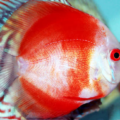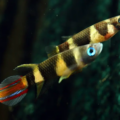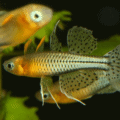Discover the most popular Hillstream Loach species and how you can make them comfortable in your home aquarium while employing them as natural algae cleaners. This article will include the best maintenance, health, tank setup, breeding, and many other tips for your Gastromyzontid.
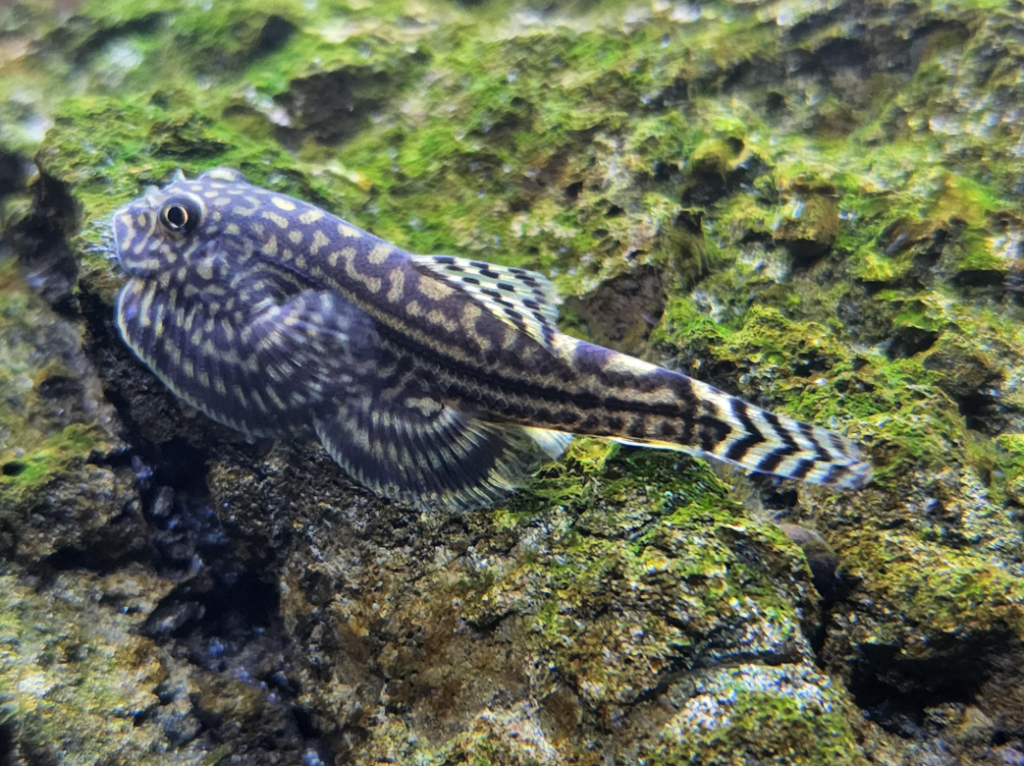
Introduction
Are you looking for a freshwater river fish that can thrive in fast-moving waters? Then, you’ll love the Hillstream Loach, a unique freshwater fish with an admirable streamlined body and an algae-eating diet.
If you want a community aquarium with multiple Hillstream Loach variants or if you do not know as yet which Hillstream loach to choose, read this Gastromyzontidae overview that covers four of the most popular species.
We’ll start this Hillstream Loach care guide with essential identification tips, then cover ways to make a well-oxygenated tank, meet their dietary needs, breed, and maximizing their lifespan.
Author’s Note: Check out these 20 Hair Algae Eaters for a SPOTLESS Aquarium for more hard working algae eaters!
Let’s start the deep dive.
Recognizing the Hillstream Loach: A Living Work of Art
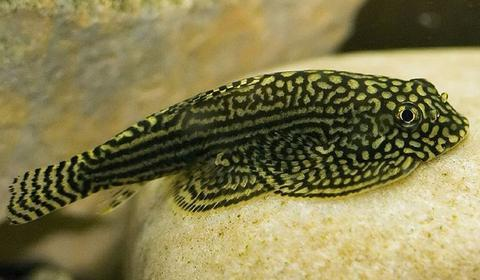
Unique freshwater bottom-dwellers often have distinctive features that are useful for identification, especially between different species.
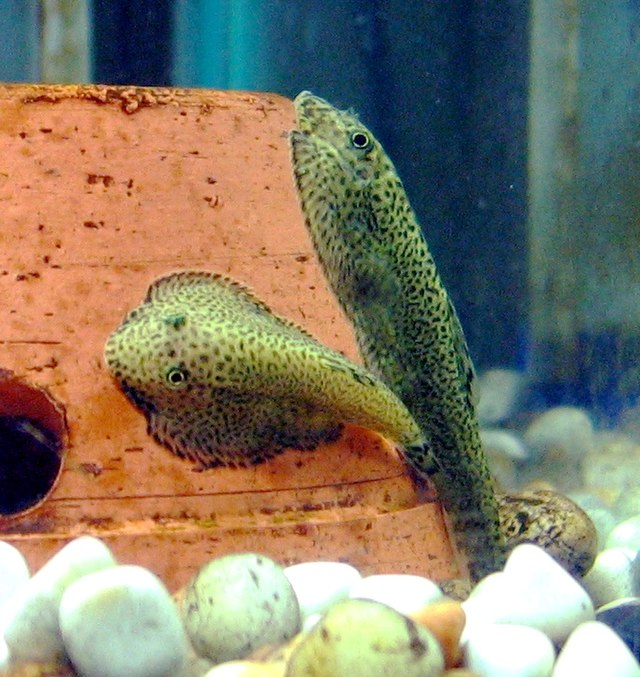
Use these tips when identifying the Hillstream Loach species, whether it’s the Reticulated (Sewellia lineolata), Chinese Butterfly (Beaufortia Kweichowensis), or Spotted Borneo Sucker (Gastromyzon punctulatus). Each species has variations in its shape, size, and coloration.
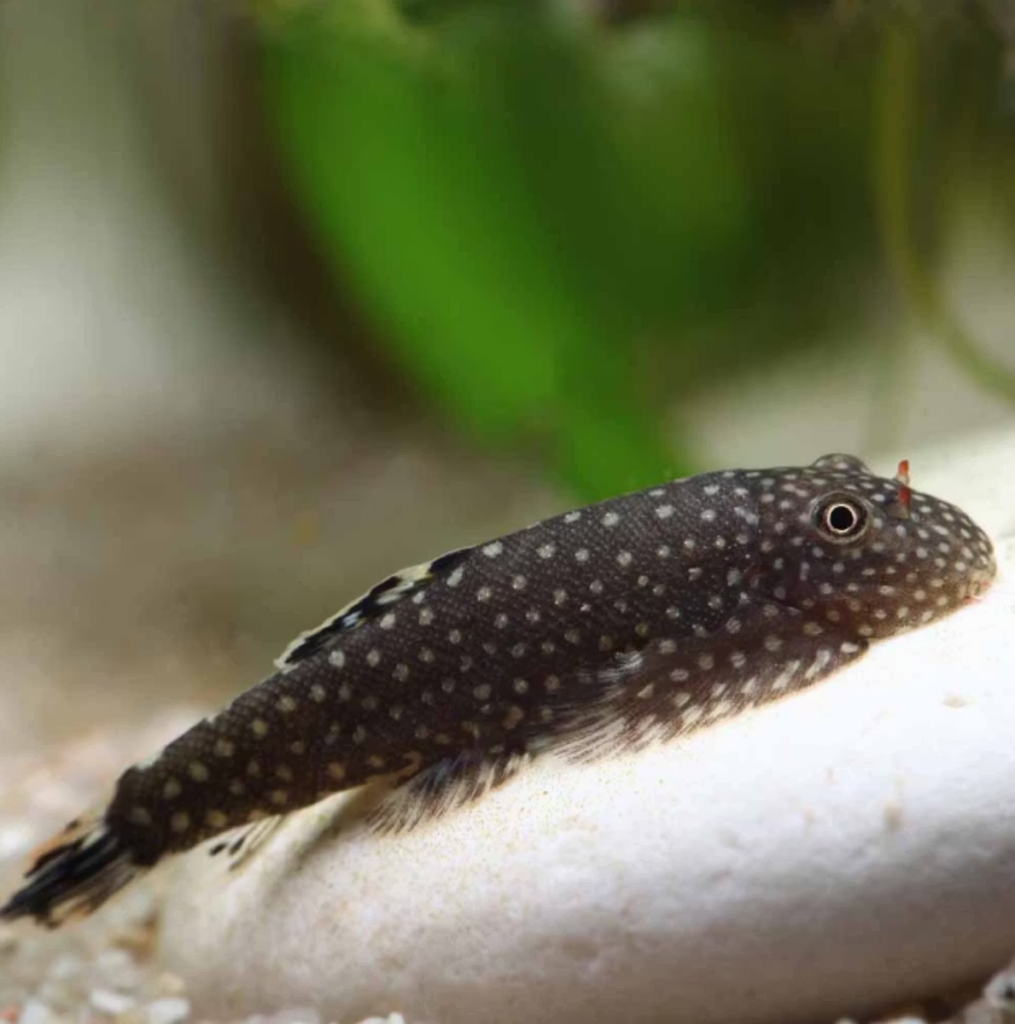
Color Pattern
| Reticulated Hillstream Loach | Yellow-brown base with maze-like reticulated patterns. |
| Chinese Butterfly Hillstream Loach | Olive-green/Brown almost pale base with dark spots |
| Spotted Borneo Sucker Hillstream Loach | Brown/Gray base with lighter colored spots and speckles |
Sewellia lineolata is also called the Tiger Hillstream Loach because of their unique Sewellia lineolata markings, referring to their bold stripes and polygonal color patterns, with base colors ranging from golden-yellow to beige, tan or light brown.
Unique Traits
| Appearance | Personality | |
| Reticulated Hillstream Loach | Flattened body, Wide Pectoral and Pelvic Fins, and upturned eyes on a Small Round Head. | Most Active, Curious, Territorial |
| Chinese Butterfly Hillstream Loach | Rounded body, paddle-like Pectoral and Pelvic Fins. | Reserved, Less active, prefers latching to large surfaces like big rocks |
| Spotted Borneo Sucker Hillstream Loach | Elongated body, narrow Pectoral and Pelvic Fins. | Most Peaceful and Less Territorial |
Despite their differences, every Hillstream Loach loves socializing and grazing on algae. So keep them in groups and rest easy about tank maintenance because they’re natural cleaners. Now, let’s design a tank that suits these unique traits.
Setting Up the Perfect Habitat for Hillstream Loach
When designing a natural, fast-flowing freshwater river aquarium environment like the Hillstream Loach’s habitat, you must meet key tank requirements especially suited to their unique habitats.
| Sewellia lineolata | Vietnam, Laos, Cambodia |
| Beaufortia kweichowensis | China |
| Gastromyzon punctulatus | Malaysia, Indonesia |
Get the right tank size and layout, set optimal water parameters with strong filtration and high oxygenation, and balance aesthetics and comfort when choosing their decor.
Tank Layout
Hillstream Loaches will thrive in long rectangular tanks with at least 20 gallons of water per small group of 3 – 6. Ensure it’s a well-established and adequately oxygenated tank with ample water movement.
Design a layout that gives your pets access to enough algae and provides a safe space for their existence using the tidbits we provided about their natural habitat.
Water Parameters
The Sewellia lineolata also known as the Reticulated Hillstream Loach needs a cool habitat, moderately hard water balanced between slight acidity and alkalinity, see below.
| pH Level | 6.5 – 7.5 |
| Temperature | 72 – 78℉ |
| Hardness | 5 – 12 dGH |
The Chinese Butterfly Hillstream Loach prefers even cooler water temperatures, see below.
| pH Level | 6.5 – 7.5 |
| Temperature | 68 – 75℉ |
| Hardness | 5 – 15 dGH |
And last, the Spotted Borneo Sucker Hillstream Loach survives in slightly lower pH but thrives in slightly acidic to neutral water, see below.
| pH Level | 6 – 7.5 |
| Temperature | 72 – 78℉ |
| Hardness | 4 – 10 dGH |
Without maintaining proper water parameters, the tank’s water quality can degrade, which can cause a wide range of issues from cloudy aquarium water to illness and mass die off.
Decor Essentials
Your Hillstream Loach tank setup isn’t complete without the perfect layout. This is where you express your creativity and recreate your pet’s natural habitat while providing them comfort.
Below sections will go over specific decor considerations for each loach, you will immediately spot similarities as they are members of the same family, and they are not too picky as along as their water conditions stay consistent.
Reticulated Hillstream Loach Decor
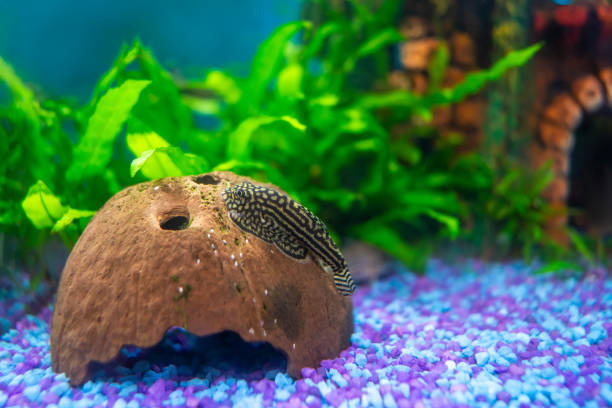
Choose smooth rocks and pebbles for algae growth, driftwood for biofilm growth and aesthetics, and fine sand to comfort their flat underbelly. They’ll need strong filtration, but be cautious that the filter’s flow won’t uproot live plants like Anubias and Java Fern.
Chinese Butterfly Hillstream Loach Decor
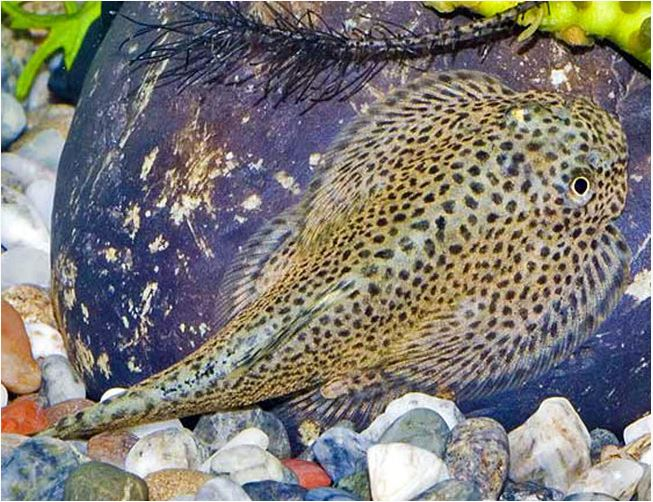
Use large rocks with round pebbles to simulate streambeds. Create hiding spots with rocks or coconut shells. Install a strong filtration system or wavemaker to increase oxygenation and Salvina plants can be used to provide shade and maintain the tank’s water quality.
Spotted Borneo Sucker Hillstream Loach Decor
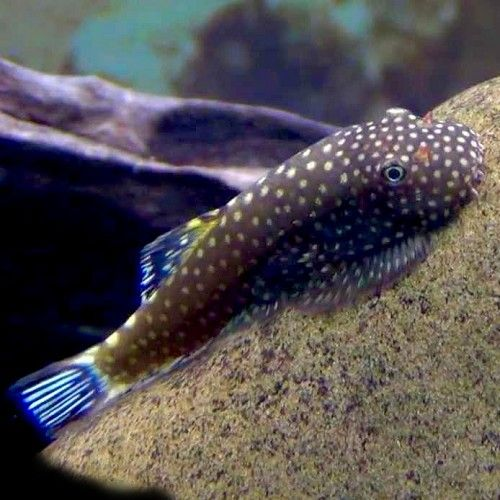
And finally for the Borneo Loach, as with the others, use fine sand or smooth gravel to ensure their safety as rocky substrates can cause irritation or even cuts to their undersides. Then to improve their tank’s aesthetic and encourage tannin distribution add some driftwood and leaf litter.
Feeding the Hillstream Loach: Algae Grazer with a Varied Diet
All Hillstream Loaches rely on biofilm and algae for nutrition. So you must provide them in your pet’s meal, and use supplemental food sources where biofilm and algae are unavailable.
Use the tips from the upcoming sections when feeding Hillstream Loaches for the healthiest results.
Diet Suggestions
They’ll naturally graze on biofilm and algae growing in the aquarium, but when the supply runs low, you should supplement their diet with algae wafers and spirulina. Also, add blanched vegetables and protein-based foods to fulfill their other nutritional needs.
For more on feeding your aquatic pets check out The Ultimate Guide to Fish Food: Pros and Cons & Best Choices!
Feeding Tips
A healthy mix of natural grazing surfaces and sinking foods gives your algae-eating freshwater fish access to food no matter where they explore in the tank. It also saves you the stress of feeding large amounts and cleaning algae or other leftovers that hillstream loaches happily eat.
Tank Mates for Hillstream Loach: Peaceful Companions
You can build a peaceful river fish community with multiple Hillstream Loach species or pair them with other compatible aquatic pets.
The companions must have similar sizes, temperaments, and environmental needs to qualify as compatible species for Sewellia lineolata, Chinese Butterfly Hillstream Loach, or Spotted Borneo Sucker Loaches.
Compatible Species
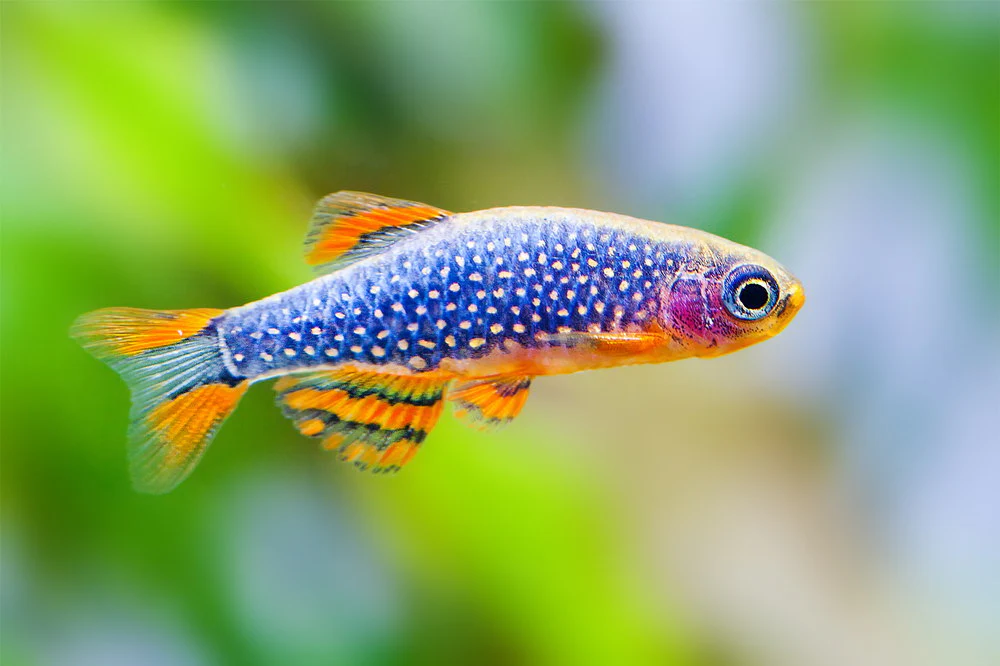
Compatible Hillstream Loach tank mates include small tetras, rasboras, danios, and other bottom-dwellers with peaceful temperaments like the lovable corydoras.
Avoided Species
Don’t keep your pets with large, aggressive fish it’ll upset the tank dynamics. They’ll become prey to larger, aggressive species.
Lifespan and Long-Term Care for Hillstream Loach
With proper Hillstream Loach lifespan care, like providing stable tank conditions, a varied diet, and compatible tank mates, your pets can live up to 8 years.
Lifespan Factors
Tank conditions, diet, and companions are the three essential lifespan factors you must cover to give your pets the best life. So follow this guide’s already mentioned health tips closely to maximize their lifespan.
Care Tips for Longevity
Freshwater bottom-dweller longevity depends on how well you follow essential care tips that affect their lifespan factors. Also ensure you observe your pets daily to quickly spot changes while taking preventive measures like keeping a pristine tank.
Breeding Hillstream Loaches: Challenges and Possibilities
Breeding Hillstream Loach fish in an aquarium is challenging because each species has unique environmental requirements. You can simulate seasonal changes by changing the tanks water with lower temperature water and faster-moving water currents to prepare them for spawning.
Breeding Setup
Maintain a tank temperature of 68 – 75 degrees Fahrenheit for a cool environment. Ensure high oxygen levels and strong filtration Add caves and smooth stones to the tank so your female Hillstream Loach can lay her eggs.
During Sewellia lineolata reproduction or any other Hillstream Loach species breeding, the males establishes territory and fertilize the eggs externally. After fertilization, freshwater fish fry care becomes your responsibility.
Fry Care Tips
Feed your pets microalgae and small protein-based foods to help them develop their muscles and physical features. Also, ensure pristine water conditions because Hillstream Loach fry is sensitive and prone to disease.
Preventing Common Health Issues in Hillstream Loach
Most Hillstream Loach species face common health concerns such as oxygen deprivation, stress from slow-moving water, and dietary deficiencies.
Preventative Measures
Preventing freshwater fish diseases starts with a good maintenance habits. Once you provide your pets with strong water flow, high oxygenation, and calcium-rich foods, you’ve significantly reduced their risk of illness.
Signs of Illness
Watch out for symptoms such as lethargy, weight loss, and fin erosion as they are signs of illnesses. You can review this Gastromyzontid wellness guide to see where you’ve gone wrong and need to adjust.
Conclusion
We’re at the end of yet another exciting review on freshwater river tank maintenance using natural algae-eaters like Hillstream Loaches. Besides their tank cleaning abilities, this species is also lovable for its peaceful nature, socialization, and active swimming habits.
Use the Hillstream Loach care essentials contained in this guide for Sewellia lineolata, Gastromyzon punctulatus, and Beaufortia kweichowensis aquarium success, and let us know how it goes in the comment box below.

